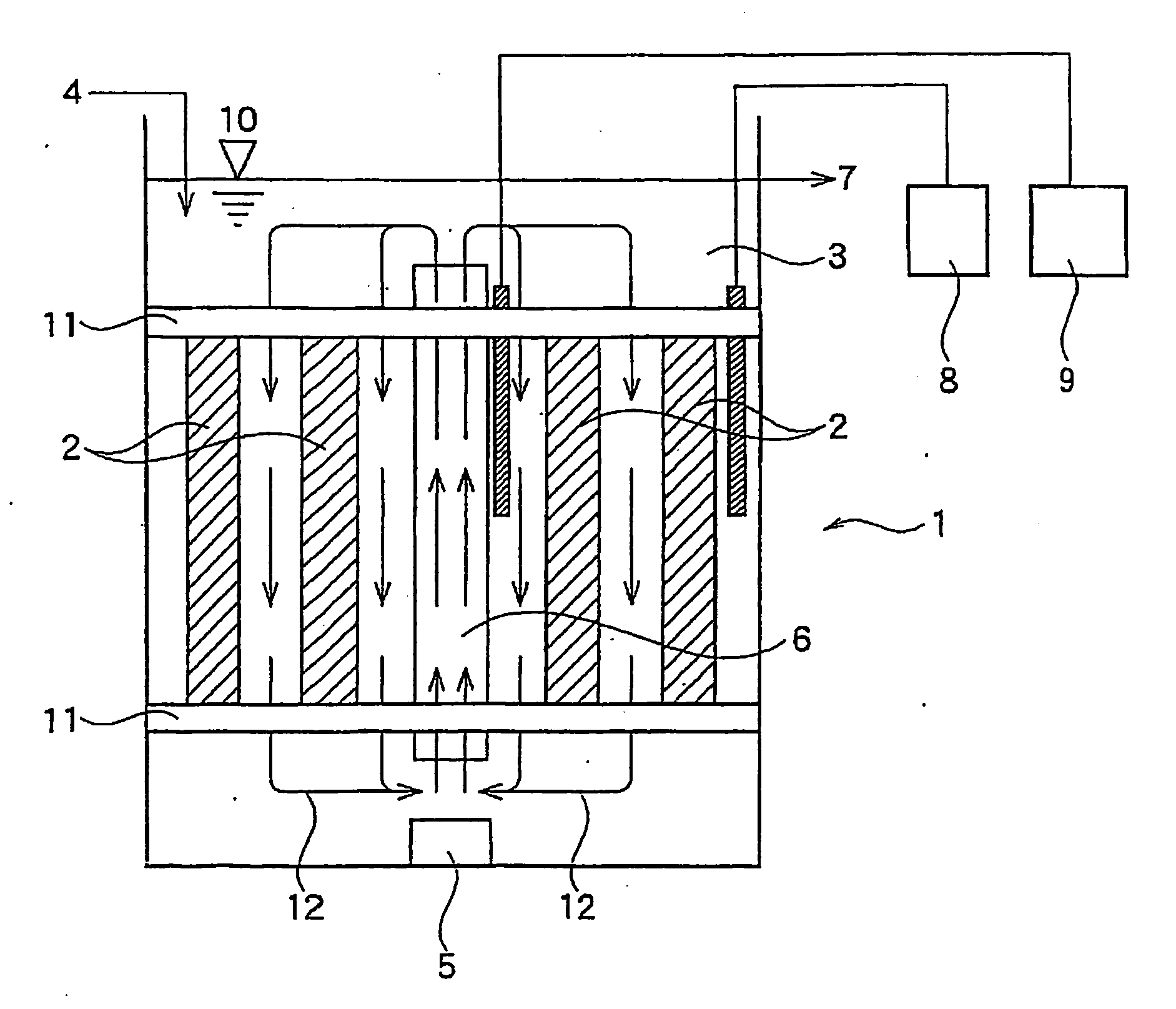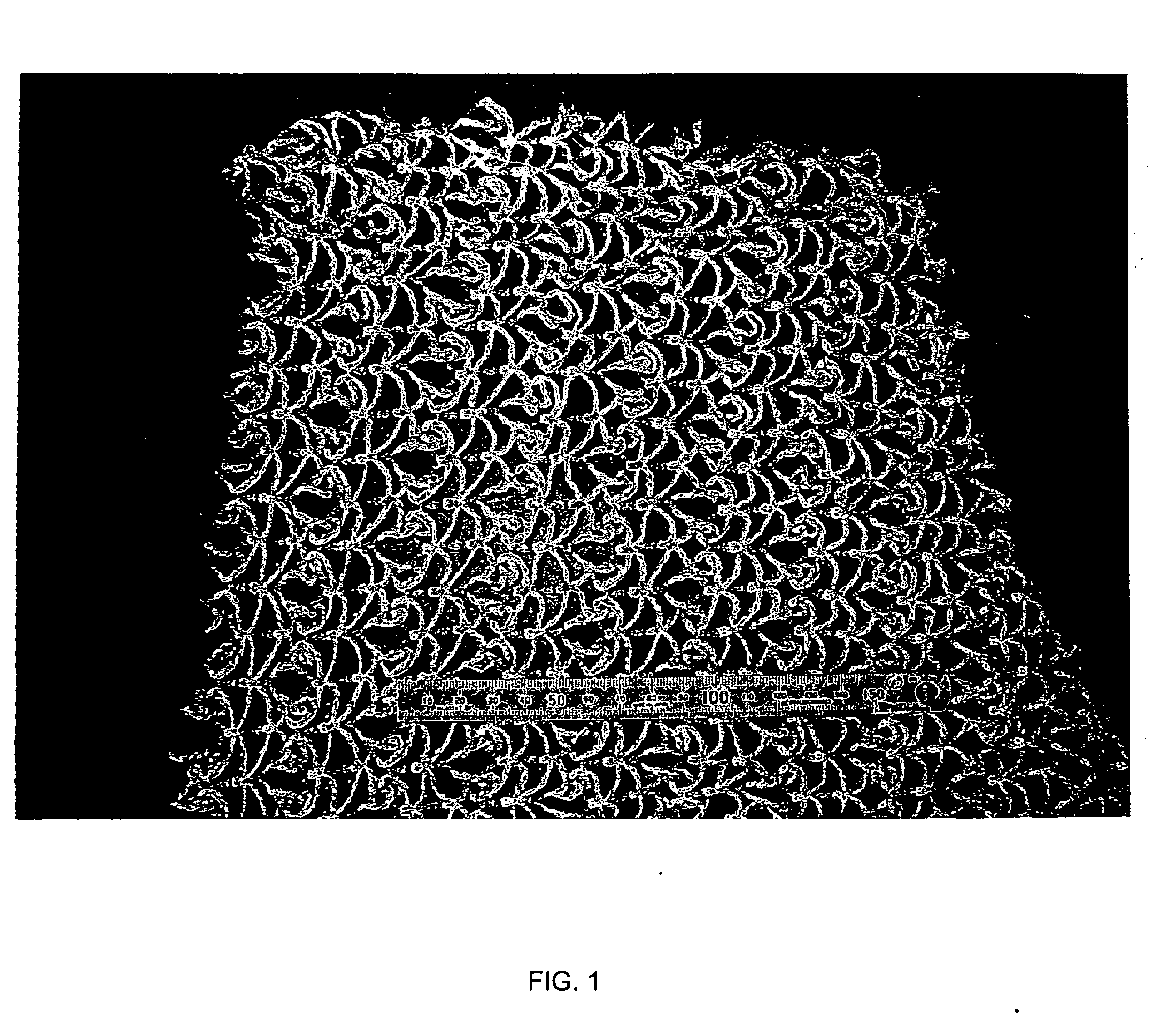Method For Treating Ammonia-Containing Wastewater
a technology for ammonia-containing wastewater and treatment methods, applied in biological water/sewage treatment, sustainable biological treatment, microorganisms, etc., can solve problems such as waste, social problems, and the need to eliminate and dispose of bacteria
- Summary
- Abstract
- Description
- Claims
- Application Information
AI Technical Summary
Benefits of technology
Problems solved by technology
Method used
Image
Examples
reference example 1
Production Example 1 of Ammonia-Treating Material
(Long Carrier)
[0128] A long carrier net composed of polyacrylic filaments as shown in FIG. 1 was used (trade name: Biofix, manufactured by NET). The net had properties shown in Table 2.
[0129] The long net was 100 mm in diameter and 330 mm in height, and was attached to a support 110 mm in length, 110 mm in width, and 330 mm in height.
TABLE 2Acrylic bulky filamentsYarn2 / 10Length23324m / m3Diameter2mmSurface area146.5m2 / m3
(Reaction Apparatus)
[0130] A reaction apparatus as illustrated in FIG. 2 was used. The apparatus included a tank that was made of an acrylic resin and was 450 mm in height, 150 mm in width, 115 mm in depth and 5.43 l in reaction part volume. Eight long carriers were attached to the supports, and were arranged in an inner peripheral area in the reaction tank. The longer direction of the carriers was perpendicular to the bottom of the reaction tank.
(Attachment and Immobilization of Autotrophic Ammonia-Oxidizing B...
example 1
[0135] Ammonia containing wastewater having a NH4—N concentration of 100 mg / l was continuously treated for 40 days using the ammonia-treating material (A) produced in Reference Example 1, at a pH of 7.5 and a water temperature in reaction tank of 35° C., and with a mean residence time of 5 hours. An inorganic salt medium shown in Table 4 was added on the 25th day from the initiation of the continuous treatment.
TABLE 4ComponentConcentrationKCl1400mg / lNaCl1000mg / lCaCl21900mg / lMgSO4•7H2O2000g / l
[0136]FIG. 4 shows concentrations of NH4—N, NO2—N and NO3—N in wastewater effluent during the continuous treatment, and FIG. 5 shows nitrogen removal (%). After the addition of inorganic salt medium on the 25th day, the NH4—N and NO2—N concentrations reduced, and the nitrogen removal increased, indicating the progress of the anammox reaction. This result showed that the autotrophic ammonia-oxidizing bacteria and the autotrophic anammox bacteria had been attached and immobilized.
[0137] The wast...
example 2
[0144] Wastewater was treated as described in Example 1 under the following conditions.
NH4—N content in wastewater influent: 240 mg / l
Volumetric NH4—N load rate: 0.58 kg / m3 / day
Mean residence time: 6 to 10 hours
Reactor DO concentration: 2 to 3 mg / l
Reactor temperature: 32.5 to 35° C.
Influent pH: 7.5 to 8.0
Air supply rate: 0.06 to 0.14 vvm
[0145]FIG. 14 shows concentrations of NO3—N in treated wastewater, and nitrogen removal (%).
[0146] The maximum nitrogen removal was 80%. The NH4—N content and DO concentration in wastewater influent were increased as compared to those in Example 1, but the anammox reaction took place and NH4—N in the wastewater was removed.
PUM
 Login to View More
Login to View More Abstract
Description
Claims
Application Information
 Login to View More
Login to View More - R&D
- Intellectual Property
- Life Sciences
- Materials
- Tech Scout
- Unparalleled Data Quality
- Higher Quality Content
- 60% Fewer Hallucinations
Browse by: Latest US Patents, China's latest patents, Technical Efficacy Thesaurus, Application Domain, Technology Topic, Popular Technical Reports.
© 2025 PatSnap. All rights reserved.Legal|Privacy policy|Modern Slavery Act Transparency Statement|Sitemap|About US| Contact US: help@patsnap.com



